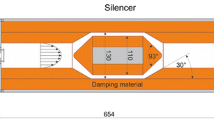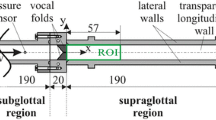Abstract
Pulsatile two-dimensional flow through asymmetric static divergent models of the human vocal folds is investigated. Included glottal divergence angles are varied between 10° and 30°, with asymmetry angles between the vocal fold pairs ranging from 5° to 15°. The model glottal configurations represent asymmetries that arise during a phonatory cycle due to voice disorders. The flow is scaled to physiological values of Reynolds, Strouhal, and Euler numbers. Data are acquired in the anterior–posterior mid-plane of the vocal fold models using phase-averaged Particle Image Velocimetry (PIV) acquired at ten discrete locations in a phonatory cycle. Glottal jet stability arising from the vocal fold asymmetries is investigated and compared to previously reported work for symmetric vocal fold passages. Jet stability is enhanced with an increase in the included divergence angle, and the glottal asymmetry. Concurrently, the bi-modal jet trajectory and flow unsteadiness diminishes. Consistent with previous findings, the flow attachment due to the Coanda effect occurs when the acceleration of the forcing function is zero.















Similar content being viewed by others
References
Adrian RJ (1996) Laser Velocimetry. In: Goldstein RJ (ed) Fluid mechanics measurements, 2nd edn. Taylor & Francis, Washington, pp 175–299
Coanda H (1936) Device for deflecting a stream of elastic fluid projected into an elastic fluid. US Patent No 2,052,869 Sept. 1, 1936
Erath BD (2005) An experimental investigation of velocity fields in divergent glottal models of the human vocal tract. M.S. Thesis, Purdue University
Erath BD, Plesniak MW (2006a) An investigation of bimodal jet trajectory in flow through scaled models of the human vocal tract. Exp Fluids 40:683–696
Erath BD, Plesniak MW (2006b) The occurrence of the Coanda effect in pulsatile flow through static models of the human vocal fold. J Acoust Soc Am 120:1000–1011
Ffowcs-Williams J, Hawkings D (1969) Sound generated by turbulence and surfaces in arbitrary motion. Philos Trans R Soc Lond Ser A 264(1151):321–342
Herzel H, Berry D, Titze I, Steinecke I (1995) Nonlinear dynamics of voice: signal analysis and biomechanical modeling. Chaos 5:30–34
Hirschberg A (1992) Some fluid dynamic aspects of speech. Bull Commun Parlee 2:7–30
Hirschberg A, Pelorson X, Hofmans GCJ, van Hassel RR, Wijnands APJ (1996) Starting transient of the flow through an in-vitro model of the vocal folds. In: Davis PJ, Fletcher NH (eds) Vocal fold physiology: controlling complexity and chaos. Singular Publishing Group, San Diego, pp 31–46
Hofmans GCJ, Groot G, Ranucci M, Graziani G, Hirschberg A (2003) Unsteady flow through in-vitro models of the glottis. J Acoust Soc Am 113:1658–1675
Ishizaka K, Flanagan JL (1972) Synthesis of voiced sounds from a two-mass model of the vocal cords. Bell Sys Tech J 51:1233–1268
Isshiki N, Tanabe M, Ishizaka K, Broad D (1977) Clinical significance of asymmetrical vocal cord tension. Ann Otol 86:58–66
Krane MH (2005) Aeroacoustic production of low-frequency unvoiced speech sounds. J Acoust Soc Am 118:410–427
Kucinschi BR, Scherer RC, DeWitt KJ, Ng TTM (2006a) Flow visualization and acoustic consequences of the air moving through a static model of the human larynx. J Biomech Eng 128:1–11
Kucinschi BR, Scherer RC, DeWitt KJ, Ng TTM (2006b) An experimental analysis of the pressures and flows within a driven mechanical model of phonation. J Acoust Soc Am 119:1–11
Lucero JC (1999) A theoretical study of the hysteresis phenomenon at vocal fold oscillation onset-offset. J Acoust Soc Am 105:423–431
McGowan RS (1993) The quasisteady approximation in speech production. J Acoust Soc Am 94:3011–3013
Mergell P, Herzel H, Titze IR (2000) Irregular vocal-fold vibration—high-speed observation and modeling. J Acoust Soc Am 108:2996–3002
Pelorson X, Hirschberg A, van Hassel RR, Wijnands APJ (1994) Theoretical and experimental study of quasisteady-flow separation within the glottis during phonation. Application to a modified two-mass model. J Acoust Soc Am 96:3416–3431
Pelorson X, Hirschberg A, Wijnands APJ, Bailliet HMA (1995) Description of the flow through in-vitro models of the glottis during phonation. Acta Acustica 3:191–202
Pelorson X, Vescovi C, Castelli E, Hirschberg A, Wijnands APJ, Bailliet HMA (1996) Description of the flow through in-vitro models of the glottis during phonation: application to voiced sound synthesis. Acta Acustica 82:358–361
Peterson SD (2001) Experimental investigations of multiple jets-in-crossflow. M.S. Thesis, Purdue University
Peterson SD, Plesniak MW (2004) Evolution of jets emanating from short holes into crossflow. J Fluid Mech 503:57–91
Rose P (1988) Phonetics and phonology of yang tone phonation types in Zhenhai. Presented at the First International Conference on Wu Dialects, Hong Kong
Scherer RC, Shinwari D, DeWitt KJ, Zhang C, Kucinschi BR, Afjeh AA (2001) Intraglottal pressure profiles for a symmetric and oblique glottis with a divergence angle of 10 degrees. J Acoust Soc Am 109:1616–1630
Scherer RC, Shinwari D, DeWitt KJ, Zhang C, Kucinschi BR, Afjeh AA (2002) Intraglottal pressure distributions for a symmetric and oblique glottis with a uniform duct (L). J Acoust Soc Am 112:1253–1256
Schutte HK, Svec JG, Sram F (1998) First results of clinical application of videokymography. Laryngoscope 108:1206–1210
Shinwari D, Scherer RC, DeWitt KJ, Afjeh AA (2003) Flow visualization and pressure distributions in a model of the glottis with a symmetric and oblique divergence angle of 10 degrees. J Acoust Soc Am 113:487–497
Smith ME, Berke GS, Gerrat BR, Kreiman J (1992) Laryngeal paralyses: theoretical considerations and effects on laryngeal vibration. J Speech Hear Res 35:545–554
Steinecke I, Herzel H (1995) Bifurcations in an asymmetric vocal-fold model. J Acoust Soc Am 97:1874–1884
Svec JG, Schutte HK (1996) Videokymography: high-speed line scanning of vocal fold vibration. J Voice 10:201–205
Wittenberg T, Mergell P, Tigges M, Eysholdt U (1997) Quantitative characterization of functional voice disorders using motion analysis of highspeed video and modeling. In: IEEE International Conference on Acoustics, Speech and Signal Processing—Proceedings v 3, Speech Processing, Digital Signal Processing, pp 1663–1666
Wolochuck MC, Plesniak MW, Braun JE (1994) Evaluation of vortex shedding flow meters for HVAC applications. Purdue University Report ME-TSPC/HERL-TR-94-1
Wolochuck MC, Plesniak MW, Braun JE (1996) The effects of turbulence and unsteadiness on vortex shedding from sharp-edged bluff bodies. J Fluids Eng 118:18–25
Zhang Z, Mongeau L, Frankel SH (2002) Experimental verification of the quasisteady approximation for aerodynamic sound generation by pulsating jets in tubes. J Acoust Soc Am 112:1652–1663
Acknowledgments
This research was funded by the National Institutes of Health grant RO1 DC03577.
Author information
Authors and Affiliations
Corresponding author
Rights and permissions
About this article
Cite this article
Erath, B.D., Plesniak, M.W. An investigation of jet trajectory in flow through scaled vocal fold models with asymmetric glottal passages. Exp Fluids 41, 735–748 (2006). https://doi.org/10.1007/s00348-006-0196-8
Received:
Revised:
Accepted:
Published:
Issue Date:
DOI: https://doi.org/10.1007/s00348-006-0196-8




